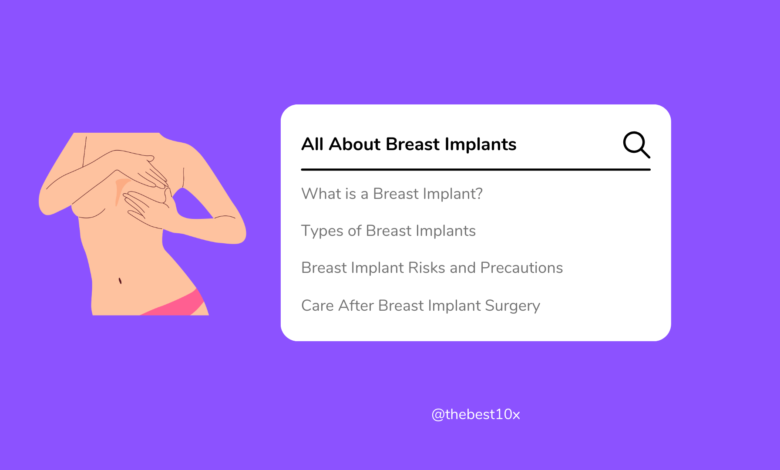
What to Know About Breast Implants (Process, Risks, Types, Surgery)
Breast implants represent a popular and effective area of the aesthetic surgery world. They offer a solution both for those who want to enlarge or shape their breasts for aesthetic purposes and for those who need breast reconstruction after mastectomy. However, in order to have a full understanding of breast implants and make the right decision, it is necessary to delve deeper into this topic. In this article, we will cover everything about breast implants and try to reveal the complexity and beauty of this surgical option. Whether for aesthetic or reconstructive purposes, here you will find everything you need to know about breast implants.
What is a Breast Implant?
A breast implant is a cosmetic surgery procedure used to change the appearance, size or shape of women’s breast area. This procedure is often preferred for patients who wish to meet their aesthetic preferences or undergo breast reconstruction after mastectomy. Breast implants consist of specially designed artificial devices that mimic natural breast tissue and usually have tissue-covered or smooth outer surfaces. These implants can be filled with fillers such as saline (sterile saline) or silicone gel. Breast implant surgery is a customized procedure in which the surgeon determines the size, shape and placement method of the implants according to the patient’s wishes and needs. In this way, patients can achieve a breast appearance that suits their personal preferences.
Why are Breast Implants Used?
Breast implants are a cosmetic surgery option used for a variety of reasons or a surgical procedure that fulfills a medical requirement. Here are the two main categories why breast implants are used:
Aesthetic Causes
- Breast Augmentation: Women opt for breast implants when they want to increase breast size or enhance their fullness. Therefore, those who want to achieve a more attractive appearance or balance their body proportions may consider this procedure.
- Changing Breast Shape: Some women seek breast implants to change their natural breast shape or to correct sagging breasts. This can often be a need after changes due to aging, weight loss or after pregnancy.
- Breast Asymmetry Correction: One breast may be smaller or shaped differently than the other. Breast implants can correct breast asymmetry and provide a more symmetrical appearance.
- Boosting Self-Confidence: Breast implants can boost a woman’s self-confidence and help her gain a more positive body image.
Breast Reconstruction
- Breast Reconstruction After Mastectomy: When one or both breasts are removed due to breast cancer treatment, women may consider breast reconstruction after mastectomy. Breast implants are used to create a new breast to replace the removed breasts. This can help patients maintain their physical and emotional well-being.
Breast implants are surgical procedures that require an individualized approach when used for aesthetic and reconstructive reasons. Each patient’s needs are different and the type of implant, size and method of surgery are determined based on the patient’s wishes and the surgeon’s recommendations. Therefore, it is important to have a detailed discussion with a plastic surgeon before planning breast implant surgery.
Types of Breast Implants
Breast implants come in several types with different types of internal fillers and external coatings. Each type of implant is selected according to the patient’s preferences, anatomical structure and surgical goals.
Here are the commonly used types of breast implants:
- Saline Filled Implants: These are implants filled with sterile saline. They can be adjusted in size and do not cause damage in case of leakage.
- Silicone Gel Implants: They are filled with soft silicone gel and offer a natural feeling. They can have a textured or smooth surface.
- Tissue Coated Implants: These are implants with a rough or textured outer surface. They are used to better stabilize the placement of the implant.
- Round and Anatomical Implants: Round implants offer a balanced appearance; anatomical implants focus on creating a natural breast shape.
- Micro-Polyurethane Coated Implants: They have a micro-polyurethane coating to stabilize the placement of the implant. Especially suitable for large implants.
These implant types are selected depending on the patient’s preferences, body structure and the surgeon’s recommendations.
Implant Selection: How to Decide?
For many women considering breast implant surgery, the most important decision is which implant to use. Here are some factors that can guide the choice of breast implant:
Breast Implant Sizes
- Breast implant sizes should be selected in accordance with aesthetic preferences and body structure.
- Customized measurement and consultation help determine the right size.
Breast Implant Shapes
- Round implants provide a fuller appearance and are often preferred, while anatomical implants focus on creating a natural breast shape.
- When deciding between the two options, the desired aesthetic result should be taken into account.
Texture Coated or Smooth Surfaces
- Implants with a tissue coating are used to better stabilize the placement of the implant, while implants with a smooth surface have a softer texture.
- Skin structure and surgical preferences can influence which surface to choose.
Place of Implant Placement (Under or Above the Muscle)
- Whether the implant is placed under the muscle or above the muscle can significantly affect the results.
- It is important to make this decision based on your personal anatomy, breast tissue and desired appearance.
Personal Preferences and Goals
- Most importantly, assess your personal preferences and goals.
- The choice of implant should help improve your body image and self-confidence.
You should discuss the choice of implant in detail with a plastic surgeon to determine which one best suits your personal needs. Getting this decision right ensures that the result of the surgery will be satisfactory.
Breast Implant Risks and Precautions
As with any surgical intervention, breast implants also have some risks. Below are some of the risks of breast implants along with precautions that can be taken.
- Infection:
- Risk: As with any surgical intervention, breast implant surgery carries the risk of infection.
- Ways of Coping:It can be treated with antibiotics. Careful wound care and hygiene after surgery can reduce the risk of infection.
- Bleeding:
- Risk: Bleeding may occur during or after surgery.
- Ways of Coping:The surgeon will intervene to control the bleeding.
- Implant Leakage or Deformation:
- Risk:Silicone gel implants have a risk of leakage or rupture.
- Ways of Coping: In case of leakage, the implant may need to be removed or replaced.
- Scar Tissue Formation:
- Risk: Scar tissue (capsule) may form around the breast, tightening the implant.
- Ways of Coping: You can help prevent or treat capsular contracture in line with your doctor’s recommendations.
- Sensory Loss:
- Risk:Some patients may experience sensory loss in the breast area.
- Ways of Coping:This is usually temporary and improves with time.
- Implant Replacement:
- Risk:Implants can change or become damaged over time.
- Ways of Coping:In line with your doctor’s recommendations, you can follow the timing of the implant replacement with regular check-ups.
- Aesthetic Results:
- Risk:Sometimes expectations may not be met in achieving the desired aesthetic results.
- Ways of Coping: It is important to clearly express your wishes and expectations to your surgeon in an open and honest communication beforehand.
If you are considering breast implant surgery, you should discuss these risks and possible complications in detail with your plastic surgeon. To minimize the risks, it is important to follow your doctor’s recommendations, follow regular examinations and take good wound care in the postoperative period. If any problems or complications arise, it is important to contact your doctor immediately.
Care After Breast Implant Surgery
Breast implant surgery aftercare is important to ensure successful recovery from the surgery and the desired results. Here are the main elements of breast implant surgery aftercare:
Rest and Recovery Process
- Rest and recovery after surgery is very important.
- You should follow your surgeon’s advice to get enough sleep and avoid heavy physical activity.
Pain and Discomfort
- Pain and discomfort after surgery is normal. You can relax by using painkillers recommended by your doctor.
Wound Care
- You should keep the scars clean and dry. You should take wound care according to your doctor’s recommendations.
- If you have stitches, you should discuss with your doctor the date set to remove your stitches.
Corset or Compression Garments
- You should wear a corset or compression garments for as long as your surgeon recommends. This can help reduce swelling.
Monitoring Scars and Bruises
- Scars and bruises are normal in the postoperative period. These conditions decrease over time.
- If you notice abnormal changes in the skin, you should contact your doctor immediately.
Physical Activity
- You should avoid heavy physical activity for the period determined by your surgeon.
- You should not start exercising without your surgeon’s approval.
Postoperative Examinations
- You should not miss the examinations recommended by your doctor. These examinations are important to monitor the condition of the implants and healing.
Smoking and Alcohol
- Smoking and drinking alcohol can delay recovery. These substances should be avoided.
Nutrition and Hydration
- A healthy diet and drinking enough water can support your recovery.
Breastfeeding and Pregnancy
- You should discuss the effects of implants on breastfeeding or pregnancy with your doctor.
Post-operative care may differ according to each patient’s condition. You should strictly follow your doctor’s recommendations and contact your doctor immediately in case of any problems or complications. Carefully monitoring your recovery and following your doctor’s advice is a critical part of a successful breast implant surgery.




